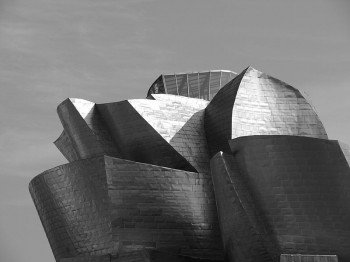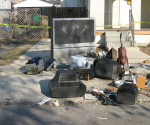6 Buildings That Defy the Rules of Architecture
When it comes down to it, most buildings look alike. There are a few, however, that defy the rules of architecture. Here are 6 of the weirdest buildings from modern architects.
The Guggenheim in Bilbao, Spain
Frank Gehry is one of the most famous architects living today. He’s also one of the most controversial. Critics have compared his buildings to eccentrically draped tissue paper. Fans say he’s nothing less than a modern genius.
The Guggenheim Museum Bilbao shows why so many people love Gehry’s unique approach to architecture. The building’s exterior has curved titanium walls that make it look severely distorted.
It’s a giant work of art created to house smaller works of art.
Gehry makes his architectural designs with help from computers. Buildings like the Guggenheim Museum require a fresh approach to design. Gehry can’t rely on the rules students learn in architecture school. Without computers keeping track of how every detail affects the building’s stability, it’s unlikely that Gehry could make such impressive designs.
That doesn’t make the building less interesting or beautiful. Great artists often use new technology to push boundaries. Gehry has found a way to make today’s tech work for him.
WoZoCo Apartments in Amsterdam, The Netherlands
Breaking the rules of architecture is one thing. Those are just rules that humans try to impose on their environments.
It’s something else to flaunt the rules of physics. Still, that’s what it looks like design firm MVRDV did when it created the WoZoCo apartments.
MVRDV’s client hired the designers to make a housing complex with 100 units for elderly residents. No matter how MVRDV looked at the site and requirements, there wasn’t a good way to make the housing units fit. That’s when someone half-jokingly started gluing units to the building’s exterior.
Suddenly, a concept appeared. It solved a crucial problem and made a unique addition to Amsterdam’s architecture.
Reiyukai Shakaden Temple in Tokyo, Japan
Shakaden Temple in Tokyo looks like an imposing, black pyramid among Tokyo’s more festive buildings. It might look like a landlocked version of the Death Star, but the monks who occupy the building use their time promoting spirituality and world peace.
The temple was built in 1975 as the headquarters of Inner Trip Reiyukai (ITR), a modern offshoot of Buddhism that started in the 1930s.
Shakaden Temple manages to look both old and futuristic. That aesthetic makes a lot of sense when one considers that ITR attempts to fuse traditional and modern concepts.
Inside, visitors will find living quarters, a large meditation room, and 400 tons of drinking water, just in case a major disaster strikes Tokyo. This is a great city to explore while in Asia.
St. Coletta School in Washington, DC
St. Coletta School breaks the rules in a fun way that makes it the perfect place for students of all ages.
While the school looks like five independent buildings, they are all connected by a central hall. Each school house has its own shape and color. That makes it look a bit strange to anyone familiar with public schools in the US.
It’s even a bigger surprise in Washington, DC, where schools have struggled to find the proper financing needed for better student performance, let alone innovative architectural features.
Inside, though, it’s fairly normal. It has a large gymnasium, a common area where students can congregate, and a kitchen fit for any gourmet restaurant. There are enough classrooms to separate students by age. Students attending St. Coletta range from 3 to 22 years old.
Since the school focuses on special needs students, it offers a nursing facility, hydrotherapy room, physical therapy program, and other therapeutic options.
OK, so maybe the interior isn’t all that normal, either. Everything about the building’s design takes a playful, enthusiastic approach to architecture.
Kubuswoningen in Rotterdam, the Netherlands
Imagine an Architecture 101 professor walking into the first day of class. She tells her students that an architect’s job is to make useful buildings that make people feel properly oriented in their environments.
Apparently architect Piet Blom skipped class that day.
Blom became famous for his 1980s building concept called, or Cube House. The buildings look like they were dreamed by a drunken E.M Escher. The bottom portion of the house looks normal. The upper portion, however, is an awkwardly turned cube.
Despite its odd look, Kubuswoningen fits unique architectural needs. The building wraps around itself, making it feel like an independent village. Stores operate out of the first floor while the upper two levels remain private for residences. The tilted windows offer sweeping views of the surrounding area. The building even creates a pedestrian bridge that lets walkers avoid a major traffic artery.
Yes, the interior space of each cube has a flat floor. Blom might have made a strange, somewhat disorienting building, but every aspect accomplishes something useful. This building breaks all the rules so it can start from scratch to create new ones.
Burj Khalifa in Dubai, United Arab Emirates
If you set out to build the world’s tallest building, you have to throw out any architectural rule that stands in your way. When someone says that you can’t possibly make a stable building that’s just shy of 830 meters tall, you have to ignore that and find a way to reach the goal.
It helps to have Emaar Properties, one of Dubai’s most successful real estate developers, backing your plan for Burj Khalifa.
Adrian Smith, who designed the building, couldn’t rely on conventional architecture to make such an innovative structure. He had to step outside of architectural standards to make the world’s tallest building. He turned to nature, where he found that a modified version of the Hymenocallis flower fit his structural and aesthetic needs.
Burj Khalifa is more than just a really tall building with interesting architectural elements. It’s a city unto itself with 30,000 apartments and 9 hotels. It has over 7 acres of parkland and a 30-acre lake.
Burj Khalifa is more like a vision of the future than a modern skyscraper.
Do you know of a rule breaking building not included in this list? What type of rules does it defy?
Guest Author: Lolita Di
















[…] 6 Buildings That Defy the Rules of Architecture – WoZoCo Apartments in Amsterdam … approach to architecture. Kubuswoningen in Rotterdam, the Netherlands Imagine an Architecture 101 professor walking into the first day of class. She tells her students that an architect’s job is to make useful … […]